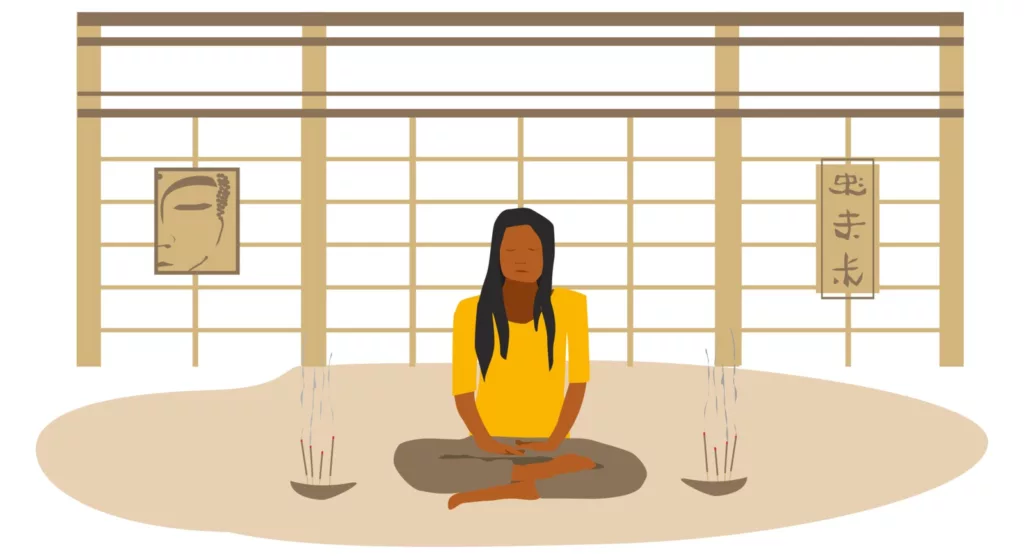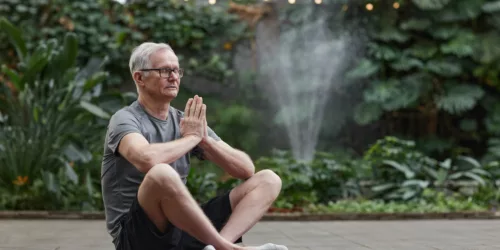What To Do After Meditation : How to Keep the Calm Going and How You Should Feel After Meditation

Meditation is an incredible practice known for its countless benefits, such as reduced stress, improved focus, and increased mindfulness.
But once you’ve finished your session, do you know what to do next? In today’s fast-paced world where everyone is constantly on the go, it’s essential to maximize the positive impact of our daily meditation practices.
This blog post will guide you through some ideal activities and practices that help consolidate the progress made during meditation, feel calm, maintain that peaceful meditative state of mind longer and ensure your overall well-being.
Key Takeaways
- After meditation, take a few deep breaths and do some light stretching or yoga to ease back into your day.
- Practicing mindfulness in daily activities such as eating, walking, cleaning, or driving can help maintain a sense of calm and focus.
- Engaging in hobbies or creative activities after meditation helps promote relaxation and self – awareness while reducing stress levels.
- Consolidating progress by setting intentions, spreading loving kindness, visualizing dreams can align thoughts and actions towards achieving goals.
The Benefits Of Meditation
Meditation provides a range of benefits, including reduced stress and anxiety levels, improved focus and concentration, and increased mindfulness and awareness.
Reduced Stress And Anxiety Levels
One of the most notable benefits of meditation is its ability to reduce stress and anxiety levels. As you incorporate this practice into your daily routine, you may find yourself becoming more resilient in the face of challenges and better equipped to cope with life’s inevitable pressures.
For example, as you immerse yourself in a tranquil meditation session, your heart rate slows down, your breathing becomes deeper and more rhythmic – all signs that your body is releasing tension and entering a state of relaxation.
This newfound sense of calm not only reduces cortisol (the “stress hormone”) levels but also strengthens our mental fortitude against future anxiety-inducing situations.
Improved Focus And Concentration
One of the most notable benefits of meditation is improved focus and concentration. Many people find that their minds are less scattered and distracted after even just a few minutes of meditation.
With improved focus, you may find yourself able to dive deeper into your work, whether it’s studying for an exam or preparing a report for work.
Incorporating mindfulness practices like meditation into your daily routine can lead to improvements in various aspects of life including mental clarity, spiritual practice, self-reflection and relaxation among others.
Increased Mindfulness And Awareness
Meditation is a powerful tool for cultivating mindfulness and awareness. By practicing meditation regularly, you can increase your ability to be present in the moment and develop a greater understanding of your thoughts and emotions.
After meditation, take some time to check in with how you feel both physically and emotionally. This self-awareness allows you to identify any areas that may need attention or adjustment.
By incorporating increased mindfulness and awareness into your daily life, you’ll find that even mundane activities take on new meaning as you become fully engaged with the present moment.
What To Do Immediately After You Meditate
After finishing your meditation, take a few deep breaths and stretch or do some light yoga to ease back into your day.
Take A Few Deep Breaths
As you wrap up your meditation session, take a few deep breaths and slowly return to the present moment. Inhale deeply, filling your lungs with air, hold for a couple of seconds, and then exhale slowly.
Deep breathing is known to stimulate the parasympathetic nervous system, which promotes relaxation and reduces stress levels.
It can also improve oxygen flow throughout the body, leading to increased mental clarity and focus. Taking these intentional breaths after meditation can help extend the benefits beyond just those that come from sitting in stillness.
Stretch Or Do Some Light Yoga
After a meditation practice, it’s important to gently move your body to promote circulation and release any tension. Here are some ways you can stretch or do some light yoga after meditation:
- Start with gentle neck stretches by slowly tilting your head side to side and then forward and back.
- Move into seated spinal twists, placing one hand on the opposite knee as you twist your torso to the side.
- Explore some cat – cow movements in a tabletop position, inhaling as you arch your spine and exhaling as you round it out.
- Come into a downward – facing dog pose and pedal out your legs, bending one knee at a time.
- Try child’s pose by sitting back on your heels with arms stretched forward, resting your forehead on the mat.
- Finish up with some seated forward folds to stretch the hamstrings and lower back.
Doing these stretches or light yoga poses after meditation will help you ease back into the physical world while maintaining a sense of calm and focus. Remember that every body is different, so listen to yours and move in a way that feels good for you today.
Write In A Gratitude Journal
One great way to build on the positive effects of your meditation practice is by jotting down things you’re grateful for in a journal. Taking a few minutes each day to make note of even the smallest blessings in life can help promote a more positive outlook and increase overall well-being.
If you’re new to gratitude journaling, consider starting with just one or two things per day and gradually building up to longer entries. You might also experiment with different formats – some people prefer basic bullet points while others enjoy writing out full paragraphs or adding photos or drawings.
Practice Mindfulness In Everyday Activities
Being mindful isn’t just about sitting in meditation; it’s also about being present and focused in your everyday activities. Here are some ways to practice mindfulness in your daily routine:
- Mindful Eating: Focus on the flavors, textures, and smells of your food instead of eating on autopilot.
- Mindful Walking: Pay attention to your surroundings and the sensations in your body as you walk.
- Mindful Communication: Listen actively and give others your full attention during conversations.
- Mindful Cleaning: Approach household chores with a sense of purpose and intentionality.
- Mindful Breathing: Take a few deep breaths throughout the day to ground yourself.
- Mindful Driving: Stay alert and aware while driving by focusing on the road and traffic around you.
By practicing mindfulness in our daily lives, we can stay more present, calm, and centered throughout our days. Remember that mindfulness is not about perfection; it’s about bringing awareness to our experiences with curiosity and kindness.
Connect With Nature
Connecting with nature after meditation can be a beautiful way to consolidate the peace and stillness cultivated during your practice. Nature provides a source of inspiration, grounding, and rejuvenation that can help you stay present and mindful in the moment.
Try taking a leisurely walk in the park or forest, sit under a tree, watch birds fly by, or appreciate the beauty of flowers blooming. Take time to breathe deeply and allow yourself to fully experience all that nature has to offer.
Engage In A Hobby Or Creative Activity
Another great way to maximize the benefits of your meditation practice is by engaging in a hobby or creative activity after your session. Engaging in an activity that you enjoy can help to ground and center you, while also promoting feelings of joy and relaxation.
Incorporating creative activities into your daily routine can also be helpful for those who struggle with stress or anxiety. Rather than succumbing to feelings of overwhelm, taking time to engage in a hobby or creative project can provide a much-needed outlet for tension and negative emotions.
Ways To Consolidate The Progress You’ve Made : Good Vibes

After meditation, it’s important to consolidate the progress made by engaging in activities like spreading loving kindness, setting an intention, and visualizing your dreams.
Spread Loving Kindness
Another way to consolidate the progress you’ve made during meditation is by spreading loving kindness. This involves directing positive energy and intentions towards yourself and others.
You can do this by silently repeating phrases like “may I be happy, may I be healthy” or “may all beings be safe, may all beings be happy”.
Research has shown that practicing loving kindness can decrease symptoms of depression and anxiety while increasing feelings of well-being and social connectedness.
It doesn’t require any special equipment or training, simply taking a few moments each day to wish goodwill towards oneself and those around us can make a significant impact on our mental health and overall outlook on life.
Set An Intention
Setting an intention after meditation can help consolidate the progress you’ve made and bring more focus to your day. An intention is a statement that reflects what you want to achieve or manifest in your life.
For example, if your intention is to have a productive day, you may be more likely to stay focused on your tasks instead of getting distracted by social media or other non-essential activities.
To set an intention after meditation, take a few deep breaths and ask yourself what matters most to you right now. You can write down one or two sentences that capture this idea and revisit it throughout the day as a reminder.
Visualize Your Dreams
Visualizing your dreams is a powerful way to consolidate the progress you’ve made during meditation. Take a moment after meditation to close your eyes and imagine yourself achieving your goals. whether it’s getting that promotion at work or running a marathon.
For example, if one of your goals is to become more confident in public speaking, visualize yourself standing on stage with ease and grace. Imagine the audience listening intently to every word you say, applauding as you finish.
Hold onto this image for a few moments before slowly coming back to reality.
Journaling
Journaling is a powerful way to reflect on your meditation experience and consolidate the insights gained. It allows you to explore any thoughts, feelings, or sensations that arose during your practice and gain deeper self-awareness.
You can start by jotting down anything that comes to mind, such as phrases, images or emotions.
Another approach is to use writing prompts related to gratitude, intention setting, or visualization exercises. For example, you could write down five things you are grateful for each day after your meditation practice.
Journaling can also be used as a tool for problem-solving or brainstorming creative ideas that surfaced during your meditation session.
Overall, journaling is a flexible and accessible mindfulness practice that allows you to deepen your connection with yourself and the world around you.
Pray Or Meditate
Another way to consolidate your progress after meditation is by engaging in prayer or further meditation. You can take a few minutes to offer gratitude or ask for guidance from a higher power, whatever that means for you.
If you prefer to continue meditating, you can explore different techniques such as chanting mantras or focusing on specific energy centers in the body. The key is to find what works best for you and incorporate it into your daily routine as a way to maintain inner peace and mindfulness.
Engage In Mindfulness Activities
Engaging in mindfulness activities after meditation can help to deepen your practice and maintain a sense of calm throughout the day. Here are some recommended mindfulness activities to try:
- Take a mindful walk or engage in mindful movement, such as yoga or tai chi.
- Practice gratitude by taking a few moments to appreciate something in your surroundings or write down what you’re thankful for.
- Focus on your breath and practice deep breathing exercises.
- Connect with nature by spending time outside, whether it’s going for a hike or simply sitting in a nearby park.
- Engage in creative activities such as drawing, painting, or writing to promote self – expression and reflection.
- Try energy work such as Reiki or acupuncture to promote relaxation and balance.
It’s important to observe how you feel after meditation and choose the activity that resonates with you the most. Remember to stay present during these activities and focus on staying connected with yourself. By incorporating mindfulness practices into your routine, you can cultivate greater awareness, inner peace, and mental clarity throughout your day.
Tips For Making Meditation A Daily Practice (Morning Meditation)
Set a regular time and place for your daily meditation sessions, gradually increasing the duration of each session to create a consistent habit; experiment with various types of meditation techniques and apps or videos to keep it interesting and engaging.
Set A Regular Time And Place For Meditation
It’s important to set a regular time and place for your meditation practice. This helps you to establish a routine, making it easier to stick with your practice over the long term.
Choose a time of day when you are least likely to be distracted or interrupted, such as first thing in the morning or before bed.
Consistency is key when it comes to building any habit, including meditation. It may take some time to get into the swing of things, but once you’ve established a consistent routine, you’ll find that it becomes easier and more natural over time.
Don’t worry if life gets in the way sometimes – just do what you can and try not to beat yourself up if you miss a session here or there.
Start With Short Sessions And Gradually Increase Time
When starting a meditation practice, it’s important to set achievable goals for yourself. Starting with short sessions and gradually increasing the time as you become more comfortable is recommended.
For example, start with five-minute sessions and gradually work your way up to ten or fifteen-minute sessions. You can even break down longer sessions into shorter ones throughout the day if needed.
Remember that meditation is not a competition or performance; it’s about creating space for yourself to connect with your mind and body in the present moment.
Experiment With Different Types Of Meditation
If you’ve been practicing meditation for a while, you might be interested in exploring different types of meditation. Here are some options to consider:
- Mindfulness meditation: This type of meditation involves focusing on the present moment and observing your thoughts and feelings without judgment.
- Loving-kindness meditation: Also known as Metta meditation, this practice involves directing love and kindness towards yourself and others.
- Transcendental Meditation: This technique involves the use of a mantra to quiet the mind and achieve a state of deep relaxation.
- Zen meditation: A form of Buddhist meditation that focuses on breath control and maintaining good posture.
- Vipassana Meditation: A traditional meditation technique from India that emphasizes self-observation and equanimity.
- Yoga Nidra: Often referred to as “yogic sleep,” this guided relaxation technique is designed to help practitioners achieve deep restorative rest.
- Chakra Meditation: This practice helps balance the energy centers in the body through visualization, breathing, and intention-setting.
Experimenting with different types of mediation can helps you find the one that resonates best with you and deepen your practice even further.
Use Guided Meditation Apps Or Videos
Guided meditation apps or videos can be an excellent way to enhance your meditation practice. They provide structure and direction, making it easier for beginners to get started with their practice.
Popular apps like Headspace and Calm offer free trials with basic features that can help you establish a consistent daily routine. Some guided meditations even feature calming sounds or soothing music that can further enhance your meditation experience.
Ultimately, the goal is not just to rely on these apps but rather integrate them into your overall mindfulness routine- allowing for continued progress toward achieving inner peace, calmness of mind and staying grounded throughout each day.
Maximizing Post-Meditation Benefits: A Scoring Guide
Meditation is a transformative practice, offering a bounty of emotional and cognitive benefits. Yet, the minutes and hours after a session are just as crucial. They form a bridge, connecting the serenity of your meditation to the vibrancy of everyday life. To optimize this post-meditation window, we’ve curated a list of activities, each scored based on its potential positive impact. Dive in to discover which practices resonate most with you :
| Rank | Activity | Score (Out of 10) | Insights |
|---|---|---|---|
| 1 | Spreading Loving Kindness (Metta Meditation) | 10 | Amplifies internal positivity, broadens emotional capacity, and fosters compassion. |
| 2 | Cumulative Benefits of Regular Meditation | 9 | Reflects the combined benefits achieved from sustained meditation, improving emotional and mental health. |
| 3 | Continuing to Sit Quietly | 7 | Reinforces the tranquil state of mind, bridging the meditation experience with day-to-day activities. |
| 4 | Journaling | 7 | Helps in understanding the meditation journey and tracking progress. |
| 5 | Mindful Walking | 7 | Encourages continuous mindfulness and serves as a gentle transition from stillness to motion. |
| 6 | Being in Nature | 8 | Enhances relaxation and connectivity to the environment, complementing meditation’s grounding effects. |
| 7 | Practice (Meditating itself) | 8.5 | Consistent practice is the foundation for reaping meditation’s multifaceted benefits. |
| 8 | Engaging in Gentle Yoga | 6.5 | Yoga helps in bodily relaxation and aligning physical and mental wellness post-meditation. |
| 9 | Listening to Soft Music | 7 | Soft tunes can prolong the feelings of tranquility and harmony experienced in meditation. |
| 10 | Deep Breathing Exercises | 7 | Aids in maintaining a calm respiratory rhythm, enhancing post-meditation relaxation. |
Overcoming Challenges With Meditation Practice And Mindfulness
Dealing with distractions and thoughts is a common challenge in meditation practice, but it can be overcome by acknowledging them without judgement and redirecting your focus back to your breath or mantra.
Dealing With Distractions And Thoughts
It’s natural to experience distractions and thoughts during meditation, but how do you deal with them? One technique is to simply observe the thought or distraction, acknowledge it, and then gently shift your focus back to your breath or mantra.
Additionally, it can be helpful to address any underlying issues that may be causing distracting thoughts. Writing down concerns or worries before meditation can help clear your mind.
Alternatively, practicing mindfulness throughout the day can also reduce racing thoughts during meditation.
Finding Motivation To Stick To A Routine
Making meditation a daily practice requires motivation and perseverance. It’s easy to skip a session, especially when life gets busy or the mind isn’t cooperating.
One way to find motivation is to connect with others who are also practicing meditation and share experiences and tips.
Another way is by setting realistic goals for oneself, starting with short sessions and gradually increasing time as progress is made. Choosing a regular time of day, whether it’s early morning or before bed, can help build consistency.
Additionally, reminding oneself of the benefits of meditation such as increased focus, relaxation, and mental clarity can help maintain motivation. Celebrating small successes along the way can also be encouraging in sticking with the routine.
Managing Expectations And Accepting Limitations
It is essential to recognize that meditation can be challenging. You might find it hard to focus, let go of thoughts, or sit still for an extended period.
These difficulties are normal and should not discourage you from continuing your practice.
For instance, if you have a busy schedule, aim for 5-10 minutes of meditation per day rather than an hour-long session right off the bat. This approach allows you to build up stamina gradually while avoiding burnout or frustration.
Another crucial aspect of managing expectations and accepting limitations is being kind and gentle with yourself throughout the process.
In summary, managing expectations and accepting limitations when practicing meditation means setting realistic goals for yourself and being compassionate towards yourself throughout the process.
The Aftermath: Savoring the Peace Post-Meditation and Transiting Mindfully
Transitioning back to your daily activities after a meditation session can be just as important as the practice itself. As you end your morning meditation, the first thing you should do is take a few moments to consolidate the progress you’ve made. Don’t hurry, take minutes to transition. Open your eyes, let your awareness slowly expand, and let your mind and body acclimatize to the external environment.
Post-meditation is a prime time to extend and imbibe the great benefits of the meditative state you’ve cultivated. One best technique that meditation teachers often recommend is journaling. This not only helps to remember the insights you gained but also allows you to assess your meditation journey with mindful introspection, without judgment. Whether you’ve spent minutes or hours of meditation, taking brief time to express gratitude for the peaceful state attained can further consolidate the positive emotions and calmness you feel after meditation.
Moreover, maintaining a dedicated meditation space can enhance your experience, especially when paired with complementary practices like yoga. These practices not only help you relax and calm your mind but also enhance concentration and focus. You might also consider a mindful walk, focusing on your breathing, allowing yourself to stay present in the moment. This way, you’re getting a transition period that doesn’t abruptly end your meditative state, but rather, softly bridges your mindfulness practice to the rest of your day-to-day activities.
Remember, every meditation session is a step in your self-development journey. Each practice helps you manage stress, deal with negative emotions, and reinforces your inner peace. So, as you open your eyes at the end of a meditation session, take deep, mindful breaths, and carry the peace and calm you’ve cultivated into the rest of your day. You’ll not only feel calmer, but the effects of meditation may also show in your daily life, positively affecting your focus, calmness, and overall good vibes. As you continue this daily practice, you’ll likely find that your sleep improves, you feel less frustrated, and even tasks that once caused trouble concentrating become manageable.
Conclusion – Feel The Effects of Meditation
In conclusion, making time for meditation in our daily routine can offer numerous benefits to our mental and physical health. But the journey doesn’t end there. After completing a session, it’s important to take a few moments to consolidate the progress made by practicing mindfulness in everyday activities or engaging in hobbies that promote relaxation and self-awareness.
By developing a consistent daily practice (frequent meditator) and experimenting with different techniques, we can cultivate inner peace, clarity of thought, and alignment with our true selves.
FAQs on What To Do and Feel After Meditation
1. Should I immediately get up and start my day after meditating, or should I take some time to relax?
It is recommended to take a few minutes to slowly transition out of your meditation practice before jumping into the rest of your day. Consider taking some deep breaths, stretching your body or journaling about any insights you gained during your meditation session.
2. How can I continue feeling relaxed and centered after my meditation practice ends?
Setting your intention and incorporating mindfulness practices into your daily routine such as mindful breathing exercises, gratitude journaling or yoga can help maintain the peaceful state achieved through meditation. Additionally, avoiding stress triggers whenever possible may also help keep you in a calm mindset for the rest of the day, in a state of mindfulness and sleep better at night.
3. Can I eat right after meditating?
It is fine to eat after meditating as long as it does not interfere with the quality of your practice (such as eating heavy meals before). Focus on choosing healthy food options that will fuel both body and mind throughout the day.
4. What are some other activities that complement a regular meditation practice?
Engaging in physical activity like exercise or going for walks outdoors can provide additional benefits by reducing stress levels and promoting mental clarity. Surrounding yourself with positive people who uplift you or engaging in activities that bring you joy can also contribute positively towards overall well-being post-meditation sessions.






